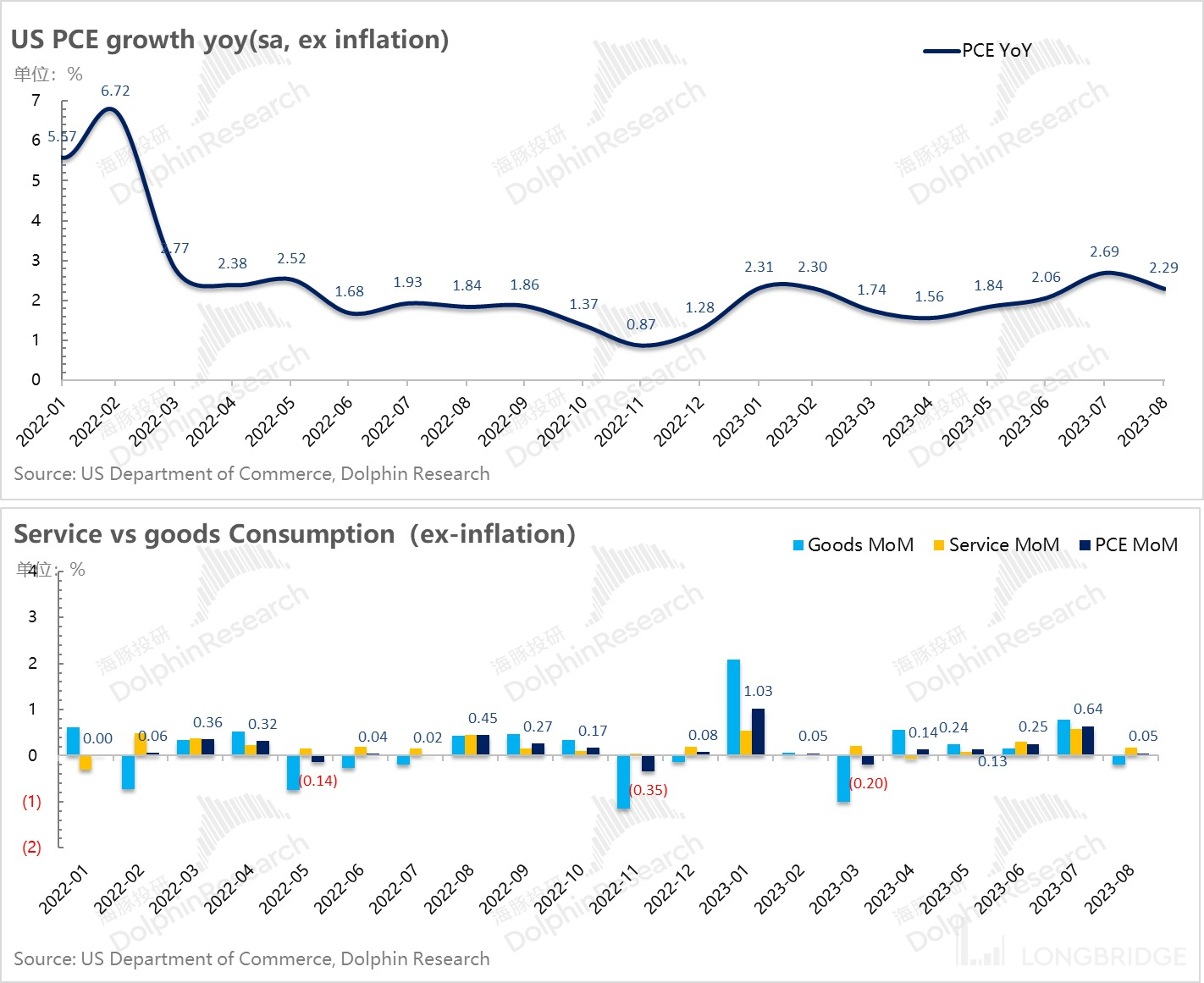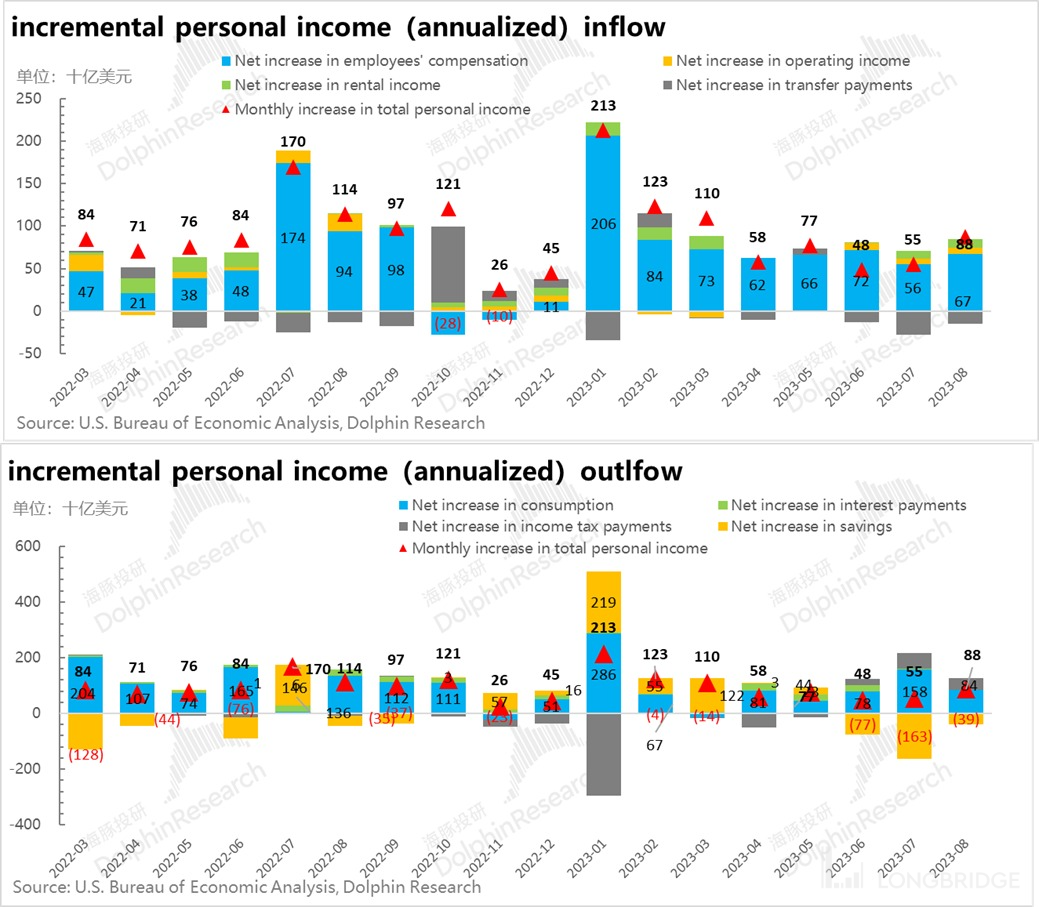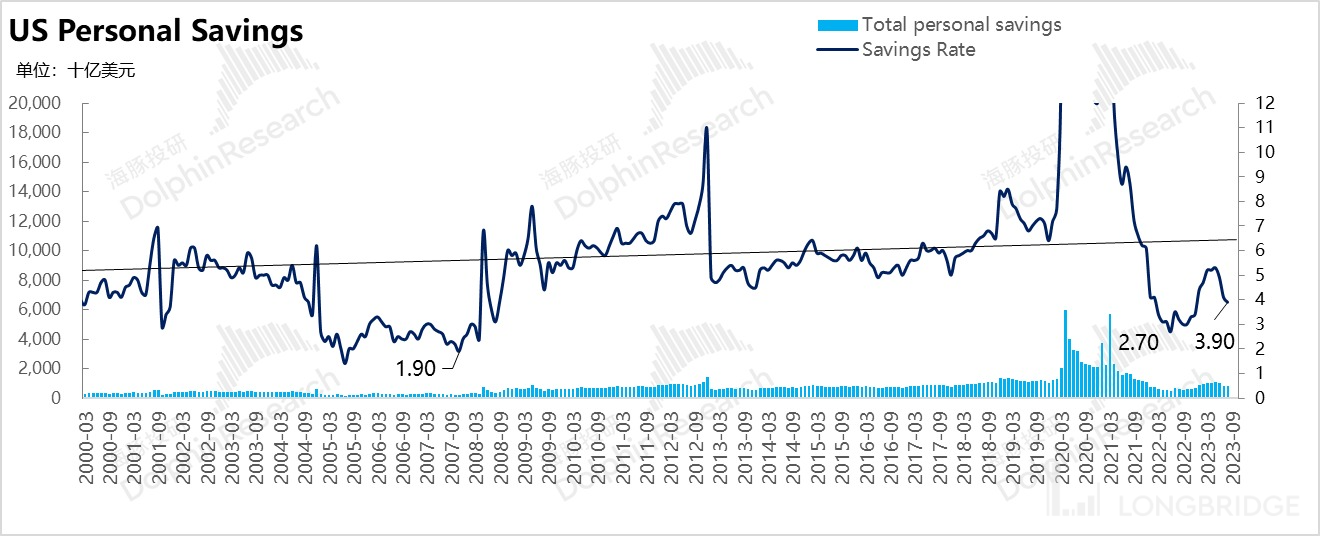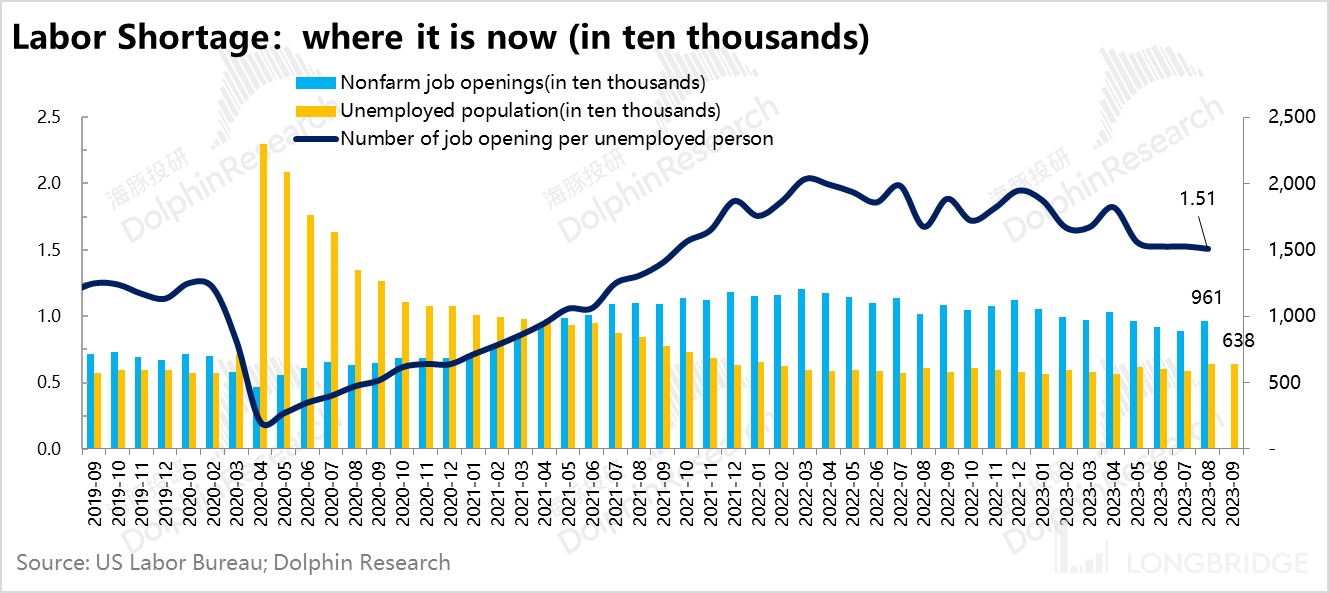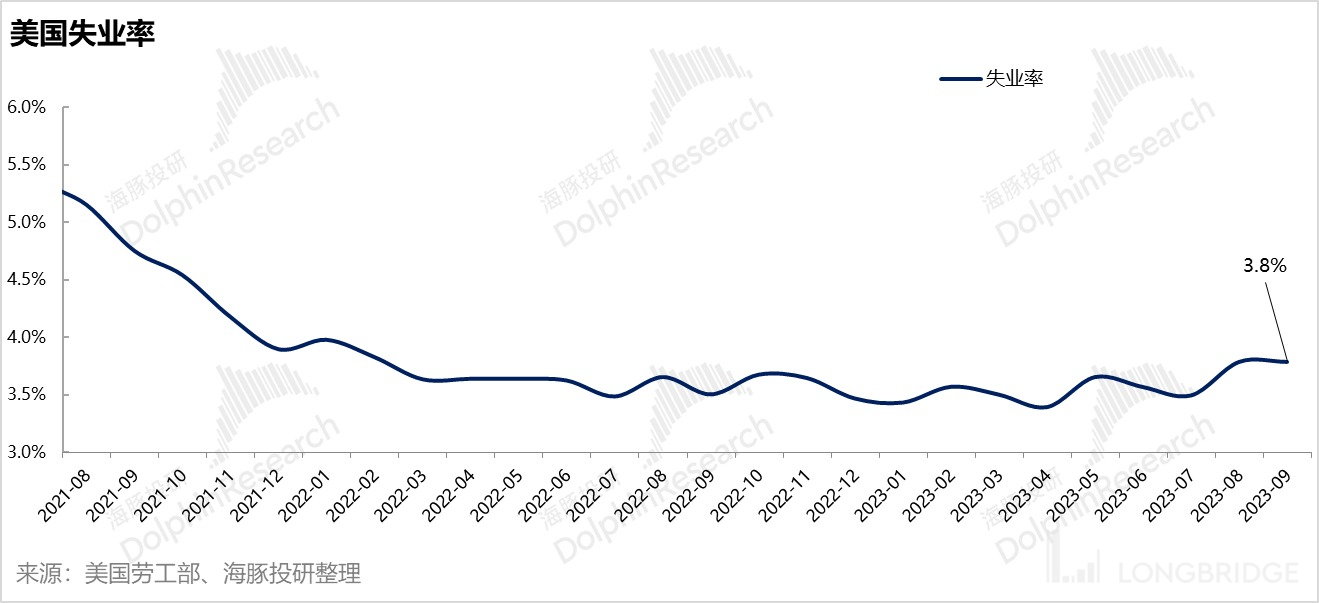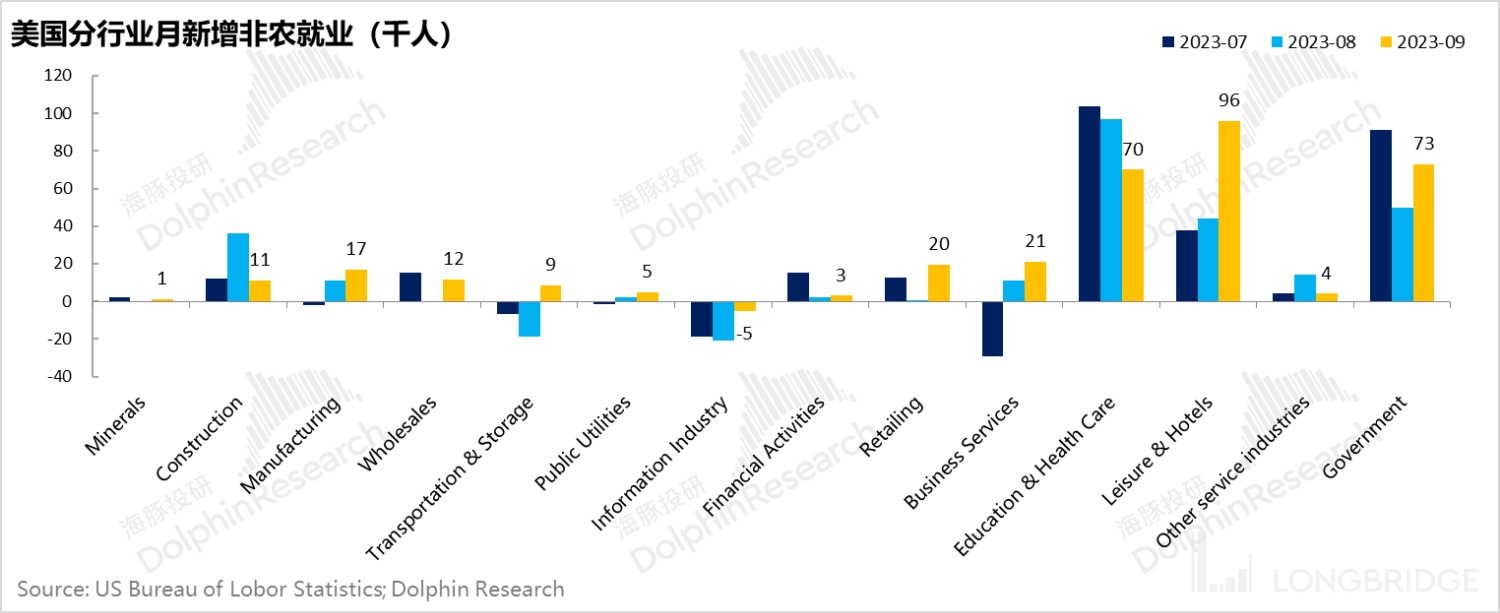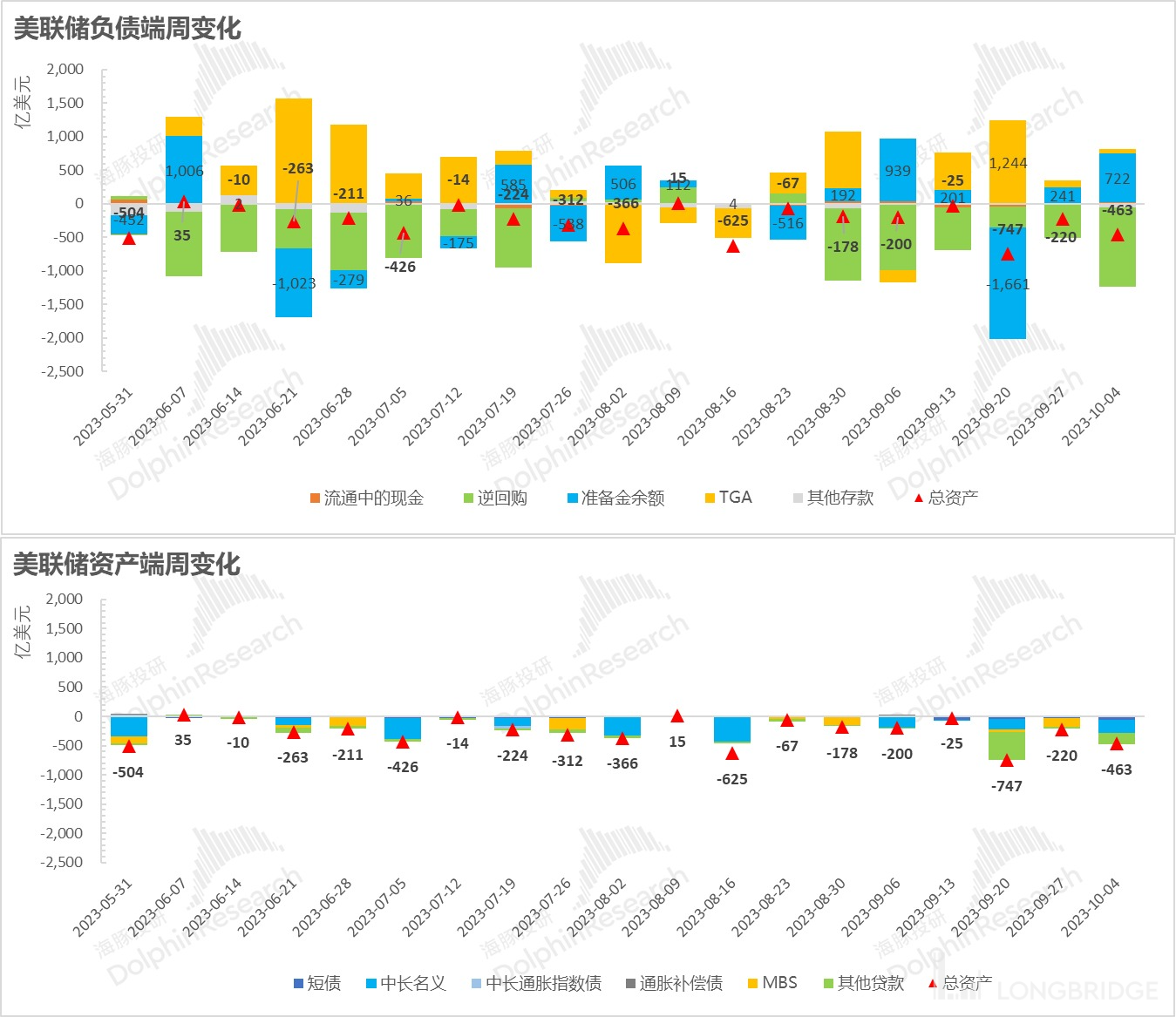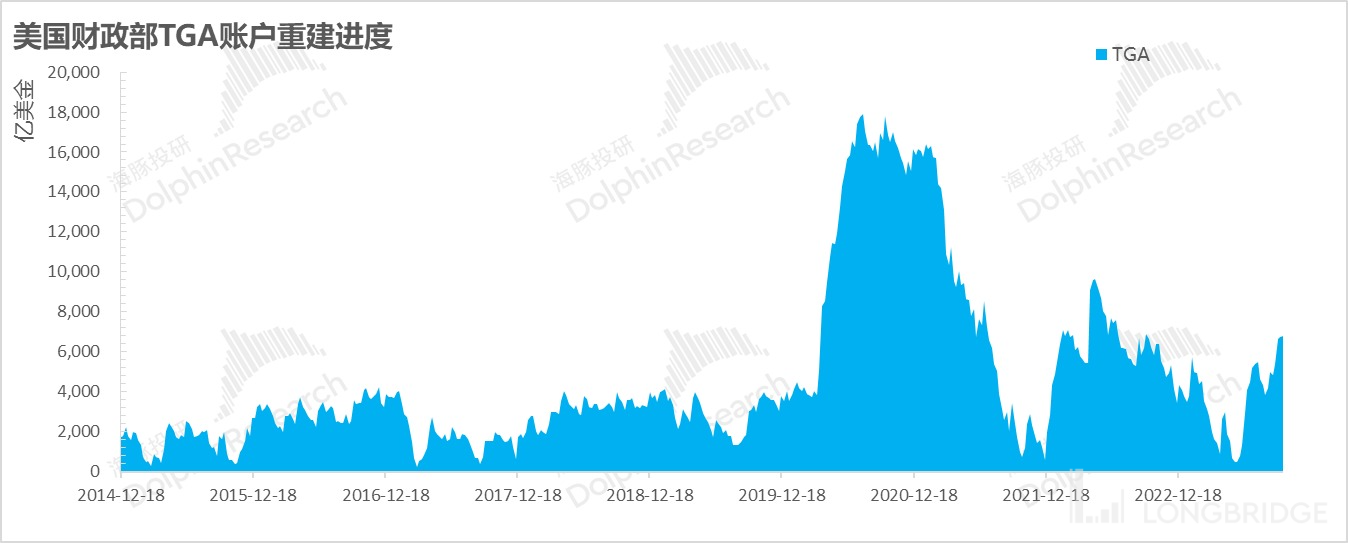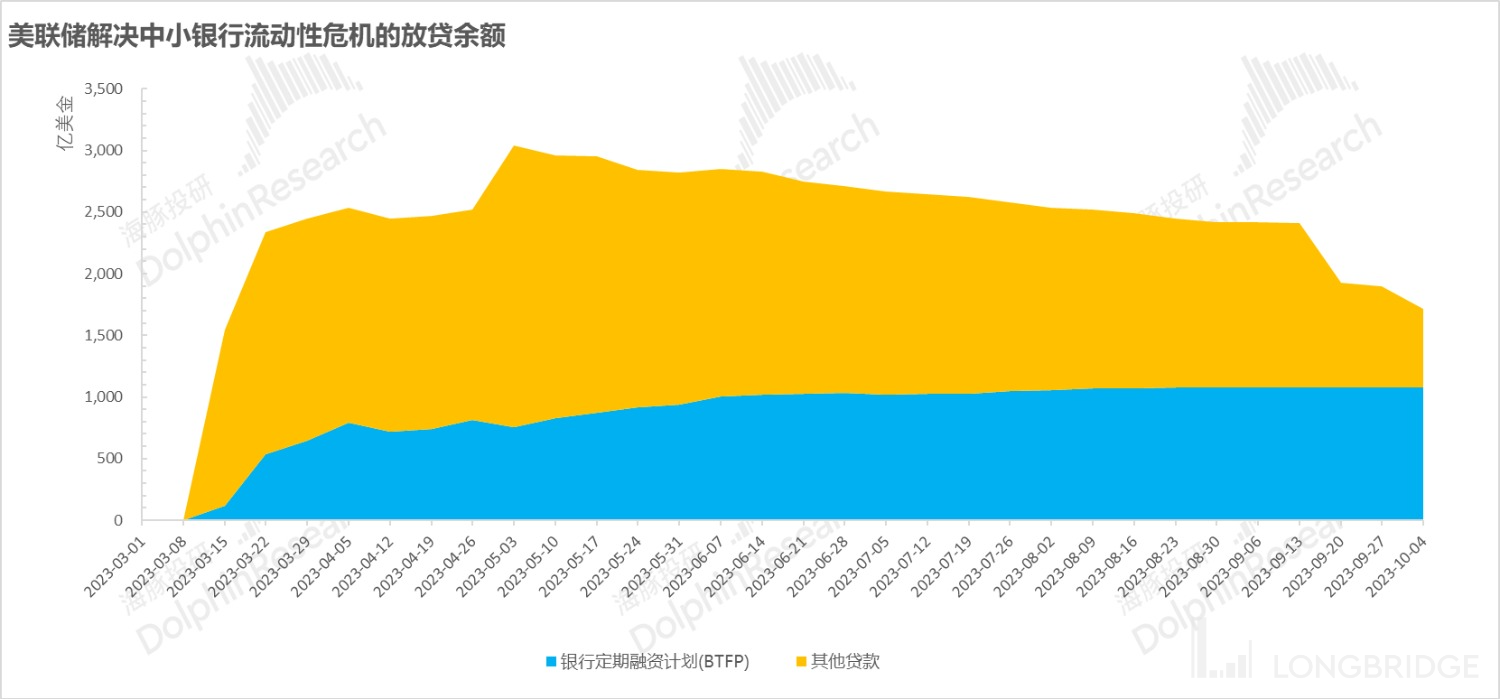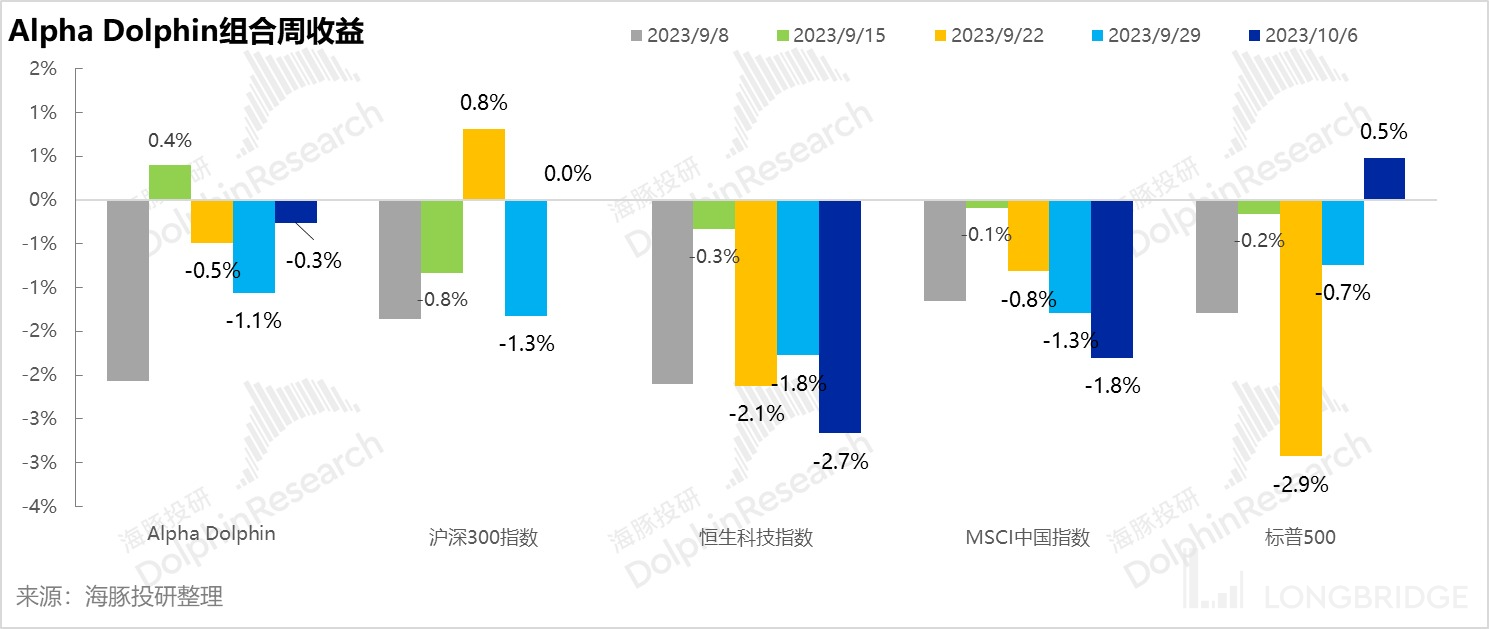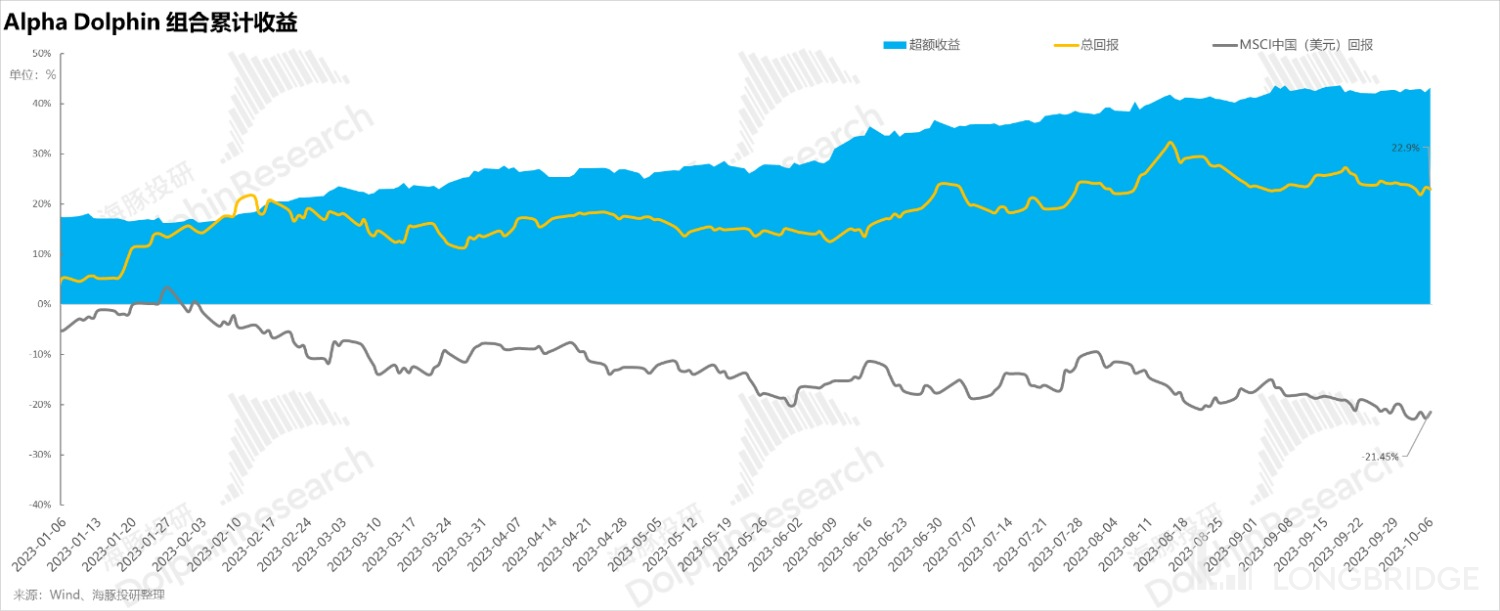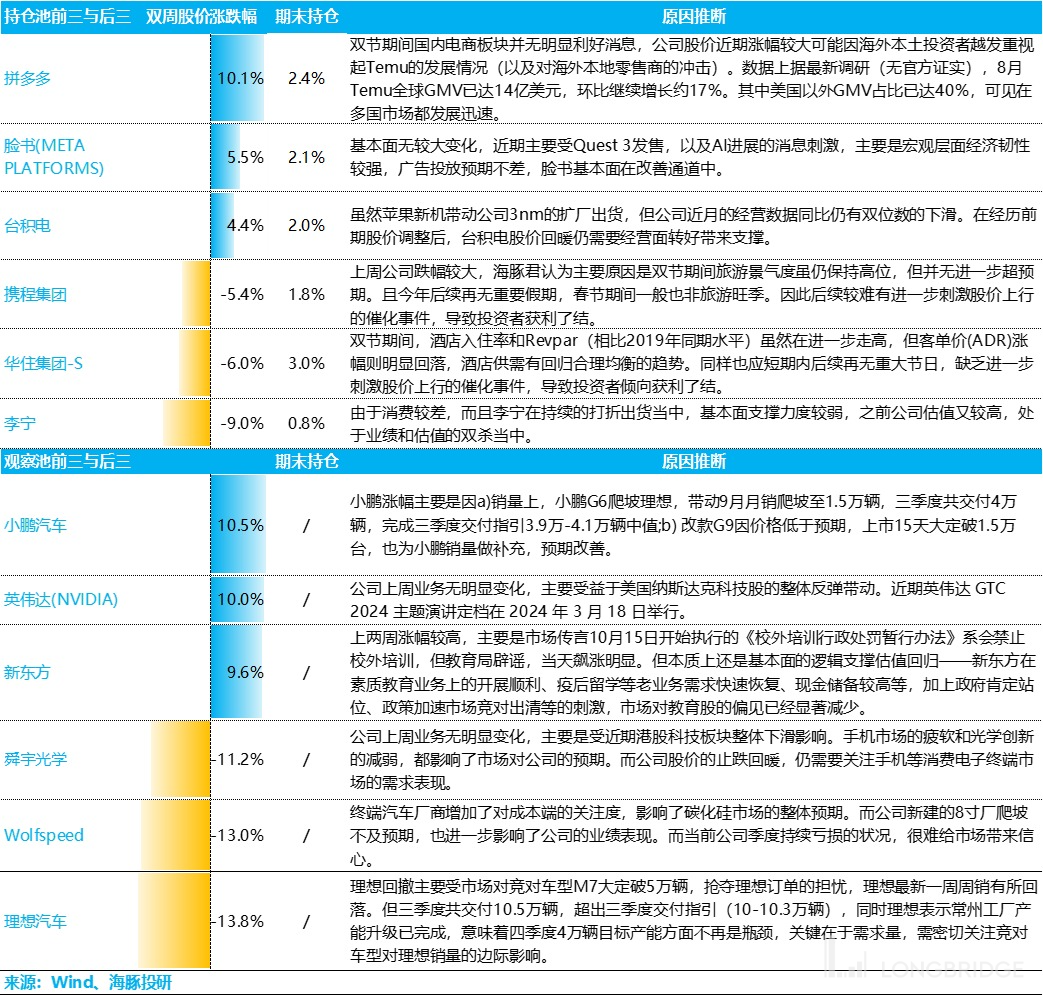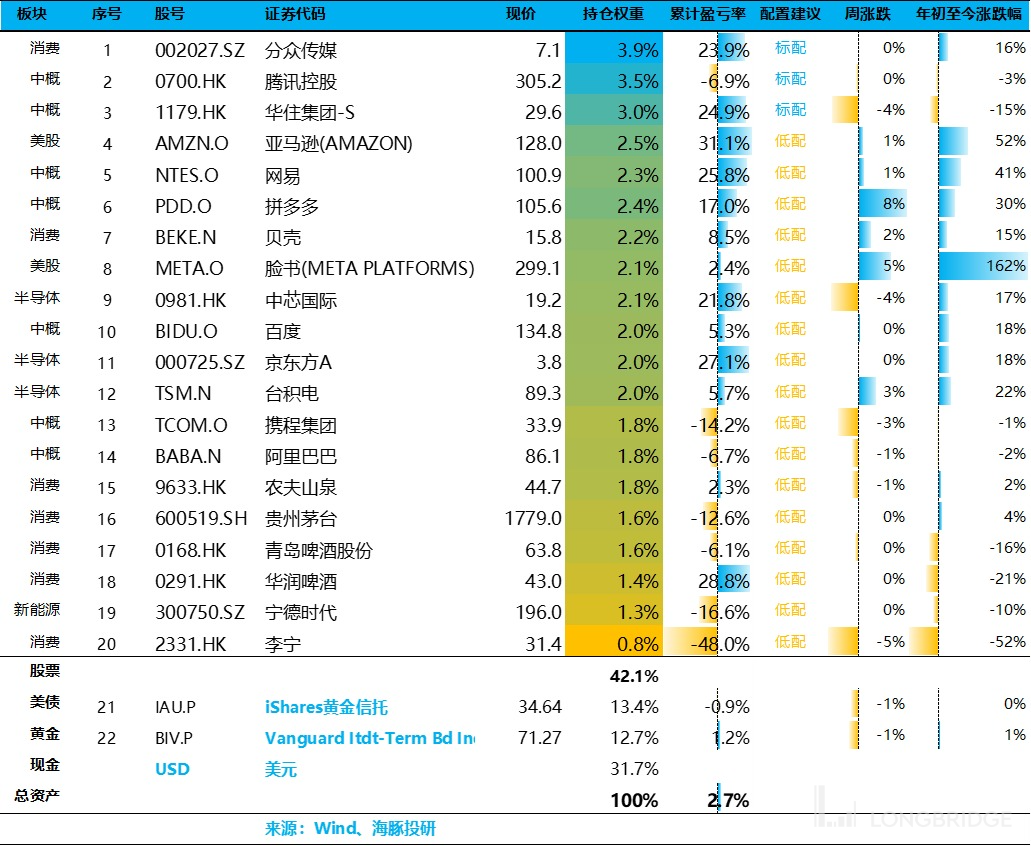Tech Making Comeback, Can US Stocks Replicate First Half's Brilliance?
Hello everyone, here is Dolphin Research's summary of the core information on this week's portfolio strategy:
1. According to the latest economic data from the United States, the effect of excess savings is reaching its later stages (people who have run out of money are starting to look for jobs again, leading to an increase in labor force participation), and the situation for individual businesses is deteriorating (reflected in the continuous slowdown of operating income among various sources of income, with a YoY drop of 1.6% in September). This has resulted in strong monthly non-farm employment, but the overall unemployment rate has started to rise.
2. Due to the increase in the overall unemployment rate in society, the supply and demand in the labor market as a whole has eased, and the wage growth rate in the United States is basically under control, with a MoM decline to 0.21% in September. There has been no so-called wage-inflation spiral, and combined with the recent decline in oil prices, it confirms that the United States is still in the process of deflating inflation.
3. Looking ahead, the space for driving consumption growth in the fourth quarter through savings consumption is relatively limited. The main reliance will be on the growth of wages and remuneration, which depends on the marginal increase in hourly wage growth and employment rate. Currently, both hourly wage growth and unemployment rate are cooling down, and there is a greater possibility of economic growth cooling down. However, these signals still point to a path of moderate landing.
4. In addition to the relationship with the fundamentals, the capital market is also greatly influenced by liquidity. Currently, from the perspective of liquidity, the reconstruction of the TGA account has completed two-thirds of the journey. However, due to ongoing selling of government bonds and the reduction of other loans by the Federal Reserve, there is still a possibility of the 10-year Treasury yield reaching 5% again. After the slowdown in economic growth in the fourth quarter, the expectation of economic speed downward, there is a high possibility of oversold rebound for US Treasury bonds in the fourth quarter.
5. In the context of overall tight liquidity in the future, in the oversold rebound of government bonds, Dolphin Research tends to believe that US stocks will also rebound. However, compared to the actual fiscal stimulus and bank crisis rescue measures in the first half of the year, the overall situation in the second half of the year will be in a state of contraction. US stocks no longer have the opportunity to earn excess returns and are likely to be a lackluster volatile market.
Here are the details:
During the week of China's National Day holiday, the most significant market aspect was the soaring US dollar and US bond yields. Dolphin Research has provided in-depth analysis and continuous tracking of this issue in the Macro Strategy Private Sharing Session in late August and the previous Strategy Weekly Report.
Before discussing this issue again, let's first look at the marginal incremental information on the US macro level during this period - August's consumer spending and September's employment data.
I. August Consumer Spending: A decline, but not weak
The release of US macroeconomic data is very interesting. The employment and wage data of the previous month at the beginning of the month basically set the tone for the macro data of the current month, while the end-of-month consumer spending (which contributes over 75% of US GDP) can basically determine the performance of the economy. Previously, Dolphin Research mentioned in the analysis of US retail sales in August that the seemingly booming retail sales were actually caused by the rebound in oil prices, which is essentially oil inflation. The consumer spending in August once again confirmed this:
In August, US consumer spending (excluding inflation) saw a significant increase for two consecutive months. After the surge in July, the MoM growth in August finally dropped to 0.05%, which means that excluding oil inflation, consumer spending in the US in August basically had zero growth. However, due to the high level in the previous month, the MoM zero growth is not considered weak. The core PCE price index, which excludes inflation, also showed a further slowdown (with a MoM increase of only 0.14%).
Among them, service consumption is the key factor. Although it has slowed down, it still saw a MoM growth of 0.17%. On the other hand, excluding inflation, commodity consumption experienced a 0.2% decline MoM due to a certain degree of decline in both durable and non-durable goods.

Looking at the two main sources driving nominal consumption growth - a) marginal income growth; b) marginal decline in savings rate, both of them show signs of nearing the end, especially the further depletion of the savings rate, which has limited space.
a) Marginal income growth - relatively stable
Looking at the five major sources of household income - employee compensation, business income, rental income, property income, and transfer payments, since the beginning of this year, transfer payments, which have been the main driver of household income during the pandemic, have continued to drag down income growth, and the growth mainly relies on employee compensation (note that employee compensation is closely related to hourly wages and employment rate).
Currently, the monthly MoM growth rate of employee compensation income, even with a large number of new jobs added every month and the unemployment rate at a historical low, is between 0.2% and 0.4%, corresponding to an annualized increase of approximately $55-76 billion per month. The total compensation growth rate for all US employees in August is already in a relatively good growth state, with a MoM growth of 0.5%.

b) How much room is there for the decline in the savings rate?
The continuous reliance on the decline in the savings rate behind the booming consumer spending means that after Americans receive their monthly income, the proportion of consumption in the outflow is increasing, continuously squeezing the money that was originally used for savings (bank deposits or investments), resulting in a continuous decline in the savings rate. The savings rate of Americans reached a historical low point in May last year and rose to 5.3% in May this year, but did not further recover to the pre-pandemic level of 6-8%. Instead, it turned downwards again to 3.9% in August. The consumption growth rate in August also exceeded the growth rate of nominal income.
The previous low point of the savings rate for US residents was before the outbreak of the 2008 US subprime mortgage crisis, when residents were accustomed to borrowing for consumption and the overall household leverage ratio was relatively high.
In Dolphin Research's view, the main factors driving the decline in the savings rate this time should be that as a whole, residents have a low debt ratio, excess savings, and a tight job market, which brings a sense of security and reduces the need for precautionary savings.
However, although the number of non-farm jobs added each month has increased significantly, the overall unemployment rate in society has been trending upwards, and wage growth has been slowing down. It is still uncertain how much additional sense of security residents have.
Currently, the savings rate has dropped below 4%, with only 3.9% in August. Considering that the savings rate was around 3% when Americans had the most excess savings last year, Dolphin Research tends to believe that the space for driving consumption growth through savings rate consumption in the fourth quarter is already limited. The focus will mainly be on the trend of nominal income growth, which is the change in employment rate and wage growth.
II. non-farm employment surging again, is the US job market really booming?
In the job market, the two numbers that are most likely to overturn everyone's perception during this National Day holiday are the number of job vacancies in August and the number of new non-farm jobs added in September.
First of all, after several months of adding new non-farm jobs to fill vacancies, the number of job vacancies in August unexpectedly increased again. Then, in September, the number of new non-farm jobs surged again, reaching 336,000, far exceeding the normal level of about 100,000 to 200,000 new jobs in a normal labor market.

What is counterintuitive is that while the number of job vacancies in the market has risen again and the number of new jobs has surged, the corresponding unemployment rate in September did not decrease, but remained at 3.8%. What is going on here?

Dolphin Research has carefully examined the data and made several interesting findings:
a) Reliability of labor department data? The majority of new non-farm jobs added in August were concentrated in the professional and business services sector. The number of job vacancies in this sector in August was approximately 1.94 million, almost equal to the number of vacancies in the education and healthcare sectors.
However, the issue is that in the previous few months, due to a gradual decline in blue-collar recruitment (reflected in the temporary employment sector, which is a significant part of the professional and business services sector), the number of job vacancies decreased rapidly. But in August, a large number of job vacancies suddenly increased. In September, blue-collar employment in this sector continued to decline. There is suspicion that the data is conflicting with each other. In addition, the significant upward revision of non-farm employment data in July and August has indeed raised doubts about the reliability of non-farm employment data.

b) Employment in the entire society, not just non-farm jobs
While there has been a surge in new job creation, employment in the entire society includes not only non-farm jobs but also agricultural and self-employed workers, accounting for about 3% of the total employed population. In September, although there was a surge in non-farm employment, the unemployment rate did not decrease. Behind this, there was a net decrease of 250,000 people in this group, resulting in an unemployment rate of 3.8%, which remained high after a previous month's increase.
c) The surge in employment in September was not driven by the professional and business services sector, but by the food and beverage industry.

Looking at the breakdown of new non-farm employment in September, apart from the government sector, the private sector was mainly driven by the food and beverage sector in the leisure and hospitality industry, while the professional and business services sector, which had a large number of job vacancies and a significant increase in August, did not see a substantial increase in new employment in September.
Therefore, combining the above information, we can see a relatively clear macroeconomic landscape:
The post-pandemic increase in e-commerce penetration, which has led to increased demand for logistics and delivery personnel, the post-pandemic reconstruction of infrastructure, and the retirement of Baby Boomers in the United States, which has increased the demand for healthcare services, have indeed created a sustained and essential demand for service-oriented jobs. This is also a key reason why the post-pandemic non-farm labor demand in the United States remains strong.
However, as the excess savings effect reaches the latter stage (when people run out of money and start looking for jobs again, leading to an increase in labor force participation rate) and the situation for self-employed individuals worsens (reflected in the continued slowdown in operating income, which has dropped to 1.6% YoY in September, and the deterioration of employment other than non-farm jobs), the overall unemployment rate has started to rise despite the strong monthly growth in non-farm employment.
Due to the overall increase in the unemployment rate in the entire society, the labor market supply and demand have eased, and the wage growth rate in the United States has remained relatively stable, with a MoM decline to 0.21% in September. There has been no evidence of a wage-inflation spiral. In addition, combined with the recent decline in oil prices, it confirms that the United States is still in the process of deflating inflation.
Looking ahead, the space for driving consumption growth through the consumption of savings in the fourth quarter is relatively limited. The remaining main driver is the growth of wages and salaries, which depends on the growth of hourly wages and the marginal increase in employment rate. Currently, both hourly wage growth and unemployment rate are cooling down, and there is a greater possibility of economic growth slowing down in the future.
III. Is a 4.5%-5%10-year bond yield sustainable?
Based on this, Dolphin Research believes that the currently high long-term bond yields in the United States may have the possibility of a decline. However, it should be noted that the yield of US bonds is not only influenced by changes in long-term inflation and expectations of real economic growth, but also by short-term liquidity.
Next, let's observe the current liquidity status through the balance sheet of the Federal Reserve:
a) The Federal Reserve's assets are still undergoing "quantitative tightening", with the sale of US bonds proceeding as planned. The recent addition of actual tightening of liquidity is the short-term liquidity tool for rescuing small and medium-sized banks by the Federal Reserve, which started on March 15 (shown as "other loans" in the following figure).
b) On the liability side, to hedge against the decline in assets and the increase in TGA deposits, the main method is still to inject liquidity by reducing reverse repurchase balances, with a small part achieved by reducing bank reserve requirements.
Looking at the bond issuance data from September, the US Treasury Department has further increased the proportion of short-term bond issuance, from below 90% to 92%. But how long can this operation last? Dolphin Research has doubts:
The government's expenses are all long-term, and financing through short-term bonds not only results in a mismatch of maturities, but also, under the current situation of yield inversion, the interest cost is higher than that of long-term bonds.
Unless the Treasury Department is also speculating that short-term interest rates will decline in the short term and is unwilling to issue long-term bonds to allow high interest costs to enter its bond portfolio in the long term, continuously financing the deficit with higher interest short-term bonds is clearly an economically inefficient way and is difficult to understand.

From the current progress, the TGA account has been rebuilt to $680 billion, which is not far from the year-end target of $750 billion. Once this part of the liquidity pressure is reduced, there may still be liquidity pressure due to the balance of liquidity injected during the liquidity crisis of small and medium-sized banks in the first half of the year. The recent pace of recovery has been significantly accelerated, indicating that there may still be liquidity pressure.


Overall, from the perspective of liquidity drainage, the most intense moment may have passed, but due to the ongoing sale of government bonds and the reduction in other loans by the Federal Reserve, it is still possible for the ten-year Treasury yield to rise again and reach 5%. However, after the economic growth slows down in the fourth quarter and the expectation of economic speed declines, it is very likely that there will be an opportunity for oversold rebound in US Treasury bonds in the fourth quarter. According to the US stock market, Dolphin Research believes that as the government bond rebounds from oversold levels, the US stock market is likely to rebound as well. However, compared to the actual fiscal stimulus and bank crisis rescue measures in the first half of the year, the overall market will be in a state of withdrawal in the second half of the year, and there will be no opportunity for the US stock market to generate excess returns.
IV. Portfolio Returns
On September 29th and October 6th, the Alpha Dolphin virtual portfolio returns were down by -1.1% and -0.3% respectively, outperforming Hang Seng Tech (-1.8%, -2.7%) and MSCI China (-1.3%, -1.8%), but underperforming the S&P 500 (-0.7%, 0.5%).

Since the start of the portfolio testing until last weekend, the absolute return of the portfolio was 21.6%, with an excess return of 43% compared to MSCI China. From the perspective of asset net value, Dolphin Research's initial virtual assets were $100 million, and currently it is $123 million.

V. Individual Stock Contribution
In the past two weeks, the Hong Kong stock market has experienced a significant decline. After a decline in the US stock market the week before, last week's employment data once again reflected the "full employment, inflation in check, and the economy still growing" perfect economic intersection. The US stock market rebounded under the leadership of technology stocks, and KWEB also performed relatively well during the holiday period, with a positive growth of 0.4% over the two weeks.
Dolphin Research has summarized the specific reasons for the rise and fall of the top companies as follows:

VI. Portfolio Asset Allocation
In the past two weeks, the Alpha Dolphin portfolio did not make any adjustments and held 20 stocks, including 3 stocks with standard ratings and 17 stocks with lower ratings. The remaining assets were allocated to gold, US bonds, and US dollars.
As of last weekend, the asset allocation and equity asset weight of Alpha Dolphin were as follows:


Risk Disclosure and Disclaimer for this Article: Dolphin Research Disclaimer and General Disclosures
Please refer to the recent articles in Dolphin Research's weekly portfolio report:
- Fed's "Iron Fist" Continues to Pound, US Stocks Can't Hold Up Anymore!
- In the Second Half of the Year, US Stocks are Mediocre, Chinese Stocks are Waiting
- Don't Panic, the Bottom for Chinese Stocks May Have Arrived
- US Unemployment Rate Rises, Hope for Chinese Stocks Arises
- Inflation vs. Siphoning, Tough Times Ahead in the Second Half of the Year
- US Fiscal Spending Like Water? The Backlash Has Arrived
- The "Brotherhood" Behind NVIDIA and Tesla, Can They Continue in the Second Half of the Year?
- Is There Redemption for Hong Kong Stocks?
- Fitch Ratings is Just a "Paper Tiger", Chinese Stocks Still Have Hope "After the violent rebound, should we stay or leave the Hong Kong stock market?"
- "Has the US interest rate hike reached its peak? Is there hope for the Hong Kong stock market?"
- "Reality strikes, how far can the rebound of Chinese concept stocks go?"
- "Looking ahead, will the US interest rate hike exacerbate stagflation?"
- "Decoding the mystery of low savings in the US, is it sustainable?"
- "US housing market: the original sin of subprime mortgages, why is it resilient this time?"
- "Unraveling the recession: where did it go after being mentioned, and can it come back?"
- "Can a short essay influence the market? Extreme optimism after extreme pessimism is the key."
- "Is the US stock market party never-ending? Economic schizophrenia, beware of excessive joy leading to sorrow."
- 《Hell vs Carnival: What are the US and Hong Kong stock markets trading?》
《US stocks pull valuation, Hong Kong stocks kill Beta? Don't despair, reversal is imminent》
《 Put high interest rates in another bank? The chances of a soft landing are even greater》
《 ChatGPT vs Performance Release, Can Giants Support the US Stock Market?》
《 Is the "US recession, China recovery" plan going down the drain?》
《 The direction of the US recession is set, it's just a minor setback, a major setback is harmful》
《 US service consumption collapses, US stocks celebrate?》
《Fed rate cut: Just waiting for a moment for the US version of Yu'EBao to strike?》
《US stocks are going to decline, interest rates are going to be cut? Anyway, trading has already taken the lead》 app_id=longbridge&channel=t4444430&invite-code=032064)
《 Silicon Valley Bank Squeeze Crisis: will the US recession run to the scene?》
《 After giving up trading in US stocks, the world can finally breathe a sigh of relief》
《Inflation confirms its existence: turning around is an opportunity》
《 Pushing inflation aside, signals in Alibaba and Baidu are more important》
《 Hong Kong and the US are both weak, but will the wolves come again?》
《High-frequency macro as a marionette, the US stock market is a puppet market》
《 A bullish single candlestick changes beliefs, Tesla leads US stocks to come back?》
《 How far away is the turbulent and changing situation of the US stock market》
《 US stocks did not have a red New Year, but strong performance is in sight?》
《 Digging up the root of the sluggishness of the US stock market》《CPI Has Fallen, Why Is the Federal Reserve Still So Hawkish?》
《Is It Really That Easy to Eliminate Service Inflation? Beware of Market Overreaction》
《Has Hong Kong Stocks Finally Found Its "Strong Backbone"? Can the Independent Trend Continue?》
《Darkness Before Dawn: Is the Key to Success Mindset During Dark Times or Dawn?》
《 The Reality of US Stocks "Fighting Back," Can Emerging Markets Still Bounce for a While?》
《Global Valuation Recovery, But There Is Still a Test of Performance》
《China's Violent Asset Boom, How Come It's a World of Difference from the US?》
《Behind the Expectation of Policy Shift: Is Unreliable "Strong Dollar Fund" GDP Growth?》
《Slowing Interest Rate Hike? The Dream of the US Fed is Shattered Again》
《 Re-Understanding a "Iron-blooded" Federal Reserve》"A Sad Second Quarter: The 'Eagle's Cry' Rings Loudly, Collective Crossing Difficulties"
"Falling to Doubt Life, Is There Still Hope for Desperation?"
"Violent Inflation Hammered by the Fed, Domestic Consumption Opportunities Arise?"
"Global Markets Plunge Again, Labor Shortage in the United States is the Root Cause"
"The Fed Becomes the Number One Bear, Global Markets Collapse"
"The United States Shifts Left, China Shifts Right, Cost-effectiveness of US Assets Returns"
"Layoffs are Too Slow, More Troubles Ahead for the United States"
"US Stocks Celebrate 'Funeral': Recession is Good, Strongest Rate Hike is Bearish Exhausted"
"Entering the Second Half of Rate Hikes, 'Earnings Thunder' Begins"
"The Epidemic Strikes Back, US Recession, and Changing Tides of Capital" 《China's Current Assets: "No News is Good News" in US Stocks》
《Is Growth Already a Carnival, or is the US Definitely in Decline?》
《Is the US in Decline or Stagnation in 2023?》
《US Oil Inflation, Can China's New Energy Vehicles Grow Strong?》
《As the Fed Speeds Up Interest Rate Hikes, Opportunities in Chinese Assets Arise》
《US Stock Inflation is Exploding Again, How Far Can the Rebound Go?》
《The Most Down-to-Earth, Longbridge Dolphin Investment Portfolio is Launched》




